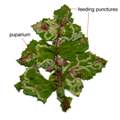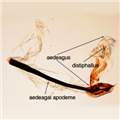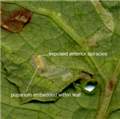
leaf symptoms on Sonchus (P. Ridland)

round, black 3rd antennal segment (M. Malipatil)

male genitalia (L. Semeraro)

puparium in leaf (P. Ridland)
Nomenclature
Chromatomyia syngenesiae Hardy 1849
Agromyza atricornis Meigen 1830 nomen dubium Phytomyza atricornis (partim) Meigen 1838 sensu Hendel 1920Chromatomyia syngenesiae Hardy 1849Phytomyza chrysanthemi Kowarz in Lintner 1891Phytomyza syngenesiae Griffiths 1967
Common names: chrysanthemum leafminer, cineraria leafminer
Hosts
Feeds almost exclusively on Asteraceae (Dempewolf 2004) and has been identified on only two hosts in other families - Daucus (Apiaceae) and Pisum (Fabaceae) (Spencer 1990).
Distribution
Europe: Austria, Belgium, Croatia, Denmark, Finland, France, Germany, Ireland, Italy, Netherlands, Norway, Spain, Sweden, Switzerland, United KingdomAfrica: Canary IslandsOceania: Australia (Australian Capital Territory, New South Wales, Queensland, South Australia, Tasmania, Victoria, Western Australia), New ZealandNorth America: Canada, USASouth America: Colombia
Based on data from Crop Protection Compendium (2007).
Key characters
Third antennal segment and palps black. Mesonotum matt grey. Coxae black, femora black with apex yellow, tibiae and tarsi black. Costa ending at vein R4+5, second (outer) cross-vein (dm-cu) absent. This species cannot be distinguished from C. horticola on external morphology but the male gentitalia are different (Griffiths 1967, 1972; Spencer 1973). Distiphallus weakly developed and only divergent towards its apex, Y shaped.
Notes
The larva forms a narrow, linear mine on the upper or lower leaf surface. Pupation is in the mine (Spencer 1973). Limited information on its ecology in Australia was given by Kleinschmidt (1970) and Spencer (1977). Bjorksten et al. (2005) recorded the following parasitoids as the most abundant in a survey of agromyzid leafminers in Victoria: Diglyphus isaea Walker, Trigonogastrella parasitica Girault, Closterocerus mirabilis Edwards & La Salle and Dacnusa areolaris (Nees ab Esenbeck). In the Australian Capital Territory, Lambkin et al. (2008) found that T. parasitica, Hemiptarsenus varicornis (Girault) and a group of 6 Opius spp. to be the most abundant parasitoids reared from Chromatomyia syngenesiae. However, unlike in Victoria, no specimens of Diglyphus isaea were reared from C. syngenesiae in the ACT. Although Belokobylskij et al. (2004) recently described 3 Australian Opius spp. reared from agromyzid leafminers, the new records from ACT indicate that further taxonomic research is needed in this group. Wharton & Austin (1991) provide additional information on Dacnusa areolaris in Australia. Common agromyzids in southern Australia, such as Liriomyza chenopodii, L. brassicae and C. syngenesiae (usually on Sonchus oleraceus) on weeds and other non-crop plants would act as important reservoirs for populations of parasitoids of any invasive polyphagous agromyzids. The biology of C. syngenesiae was documented by Cheah (1987) and Ibrahim & Madge (1977).
A recent phylogenetic study of the Agromyzidae employing molecular markers (Scheffer et al. 2007) showed that Chromatomyia was in fact a polyphylectic genus, suggesting that this genus should now be included in Phytomyza.
References
Belokobylskij SA, Wharton RA & La Salle J (2004). Australian species of the genus Opius Wesmael (Hymenoptera: Braconidae) attacking leaf-mining Agromyzidae, with the description of a new species from South-east Asia. Australian Journal of Entomology 43: 138-147.
Bjorksten TA, Robinson M & La Salle J (2005). Species composition and population dynamics of leafmining flies and their parasitoids in Victoria. Australian Journal of Entomology 44: 186-191.
Cheah C S-J (1987). Temperature requirements of the chrysanthemum leaf miner, Chromatomyia syngenesiae [Dipt.: Agromyzidae] and its ectoparasitoid, Diglyphus isaea [Hym.: Eulophidae]. Entomophaga 32: 357-365.
Crop Protection Compendium (2007). 2007 Edition � CAB International, Wallingford, UK.
Dempewolf M (2004). Arthropods of Economic Importance - Agromyzidae of the World (CD-ROM). ETI. University of Amsterdam, Amsterdam. https://agromyzidae.linnaeus.naturalis.nl/linnaeus_ng/app/views/species/nsr_taxon.php?id=57027&epi=55
Griffiths GCD (1967). Revision of the Phytomyza syngenesiae group (Diptera, Agromyzidae), including species hitherto known as "Phytomyza atricornis Meigen". Stuttgarter Beitr�ge zur Naturkunde 177: 1-28.
Griffiths GCD (1972). Comment on Steyskal's note on Phytomyza horticola Goureau and P. syngenesiae (Hardy) (Diptera, Agromyzidae). Entomological News 83: 39-40.
Hardy J (1849). On the primrose-leaf miner; with notice of a proposed new genus, and characters of three species of Diptera. Annals and Magazine of Natural History 4: 385-392.
Hendel F (1920). Die pal�arktischen Agromyziden: Prodromus einer Monographie. Archiv f�r Naturgeschichte (A) 84: 109-174.
Ibrahim AG & Madge DS (1977). The life cycle of the chrysanthemum leaf-miner, Phytomyza syngenesiae (Hardy) with reference to its larval development and behaviour. Entomologist�s Monthly Magazine 113: 1-7.
Kleinschmidt RP (1970). Studies of some species of Agromyzidae in Queensland. Queensland Journal of Agricultural and Animal Sciences 27: 321-384.
Lambkin CL, Fayed SA, Manchester C, La Salle J, Scheffer SJ & Yeates DK (2008). Plant hosts and parasitoid associations of leaf mining flies (Diptera: Agromyzidae) in the Canberra region of Australia. Australian Journal of Entomology 47: 13-19.
Lintner JA (1891). Seventh report on the injurious and other insects of New York State. Report of the New York Museum 44: 199-246.
Meigen JW (1830). Systematische Beschreibung der bekannten europ�ischen zweifl�geligen Insekten. Sechster Theil mit zw�lf Kupfertafeln 6: 166-196.
Meigen JW (1838). Systematische Beschreibung der bekannten europ�ischen zweifl�geligen Insekten. Siebenter Theil oder Supplementband. 7: 396-407.
Scheffer SJ, Winkler IS & Wiegmann BM (2007). Phylogenetic relationships within the leaf-mining flies (Diptera: Agromyzidae) inferred from sequence data from multiple genes. Molecular Phylogenetics and Evolution 42: 756-775.
Spencer KA (1973). Agromyzidae (Diptera) of economic importance. Series Entomologica 9. Dr W Junk, The Hague. 418 pp.
Spencer KA (1977). A revision of the Australian Agromyzidae (Diptera). Special Publication. Western Australian Museum 8: 1-255.
Spencer KA (1990). Host specialization in the world Agromyzidae (Diptera). Series Entomologica 45. Kluwer Academic Publishers, Dordrecht. 444 pp.
Wharton RA & Austin AD (1991). Revision of Australian Dacnusini (Hymenoptera: Braconidae: Alysiinae), parasitoids of cyclorrhaphous Diptera. Australian Journal of Entomology 30: 193-206.
WWW Resources
Chromatomyia syngenesiae in Dempewolf M (2004). Arthropods of Economic Importance - Agromyzidae of the World
Chromatomyia syngenesiae, leaf symptoms in Edmunds R et al. (2008). British leafminers
Chromatomyia syngenesiae in Pitkin B, Ellis W, Plant C & Edmunds (2008). The leaf and stem mines of British flies and other insects
Chromatomyia syngenesiae, larvae, puparia in Ellis WN (2018). Plant Parasites of Europe - leafminers, galls and fungi
Chromatomyia syngenesiae in Martinez M (2007). Fauna Europaea: Agromyzidae. In Pape T (ed.) (2007) Fauna Europaea: Diptera: Brachycera. Version 1.3 [128355]
Chromatomyia syngenesiae in Australian Faunal Directory (Agromyzidae compiled by MG Elliott, Australian Museum, Sydney. Updated: 01 May 2014)




















